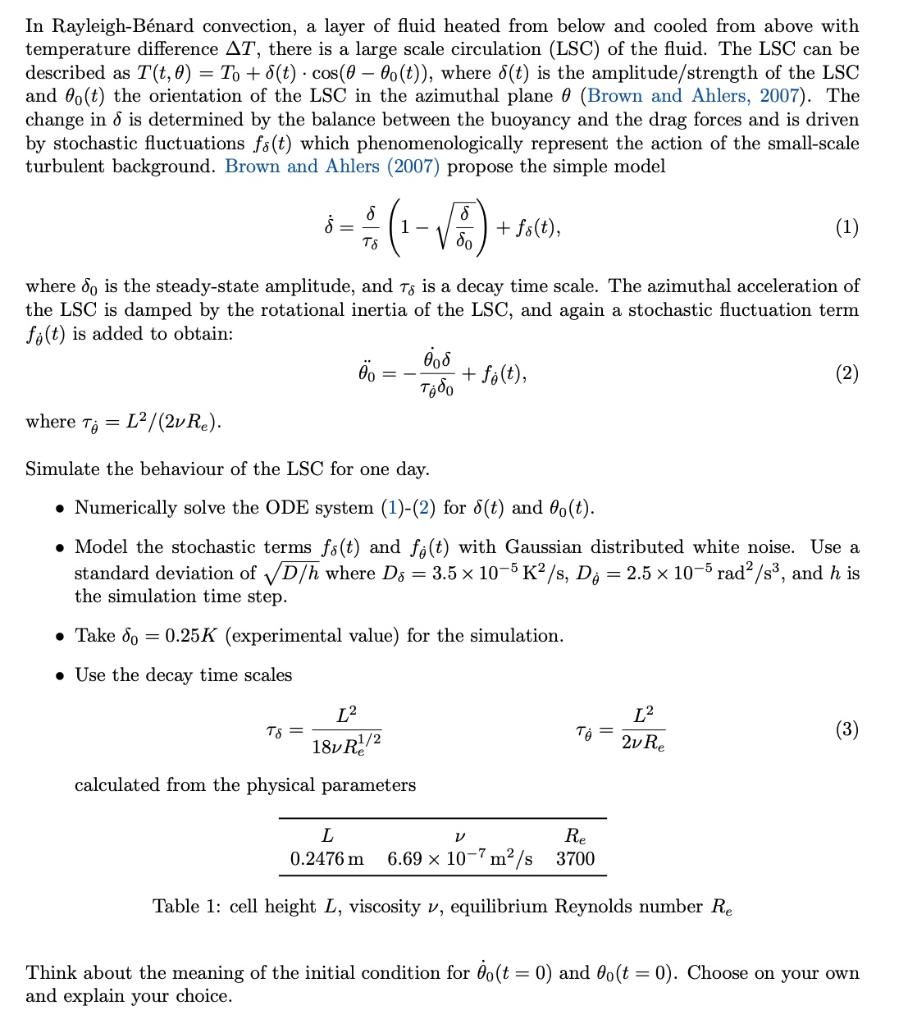

In Rayleigh-Bnard convection, a layer of fluid heated from below and cooled from above with temperature difference T, there is a large scale circulation (LSC) of the fluid. The LSC can be described as T(t,)=T0+(t)cos(0(t)), where (t) is the amplitude/strength of the LSC and 0(t) the orientation of the LSC in the azimuthal plane (Brown and Ahlers, 2007). The change in is determined by the balance between the buoyancy and the drag forces and is driven by stochastic fluctuations f(t) which phenomenologically represent the action of the small-scale turbulent background. Brown and Ahlers (2007) propose the simple model =(10)+f(t), where 0 is the steady-state amplitude, and is a decay time scale. The azimuthal acceleration of the LSC is damped by the rotational inertia of the LSC, and again a stochastic fluctuation term f(t) is added to obtain: 0=00+f(t), where =L2/(2Re). Simulate the behaviour of the LSC for one day. - Numerically solve the ODE system (1)-(2) for (t) and 0(t). - Model the stochastic terms f(t) and f(t) with Gaussian distributed white noise. Use a standard deviation of D/h where D=3.5105K2/s,D=2.5105rad2/s3, and h is the simulation time step. - Take 0=0.25K (experimental value) for the simulation. - Use the decay time scales =18Re1/2L2=2ReL2 calculated from the physical parameters Table 1: cell height L, viscosity , equilibrium Reynolds number Re Think about the meaning of the initial condition for 0(t=0) and 0(t=0). Choose on your own and explain your choice. Using the Euler-scheme. This may help: =intital+t=initial+t=initial+t In Rayleigh-Bnard convection, a layer of fluid heated from below and cooled from above with temperature difference T, there is a large scale circulation (LSC) of the fluid. The LSC can be described as T(t,)=T0+(t)cos(0(t)), where (t) is the amplitude/strength of the LSC and 0(t) the orientation of the LSC in the azimuthal plane (Brown and Ahlers, 2007). The change in is determined by the balance between the buoyancy and the drag forces and is driven by stochastic fluctuations f(t) which phenomenologically represent the action of the small-scale turbulent background. Brown and Ahlers (2007) propose the simple model =(10)+f(t), where 0 is the steady-state amplitude, and is a decay time scale. The azimuthal acceleration of the LSC is damped by the rotational inertia of the LSC, and again a stochastic fluctuation term f(t) is added to obtain: 0=00+f(t), where =L2/(2Re). Simulate the behaviour of the LSC for one day. - Numerically solve the ODE system (1)-(2) for (t) and 0(t). - Model the stochastic terms f(t) and f(t) with Gaussian distributed white noise. Use a standard deviation of D/h where D=3.5105K2/s,D=2.5105rad2/s3, and h is the simulation time step. - Take 0=0.25K (experimental value) for the simulation. - Use the decay time scales =18Re1/2L2=2ReL2 calculated from the physical parameters Table 1: cell height L, viscosity , equilibrium Reynolds number Re Think about the meaning of the initial condition for 0(t=0) and 0(t=0). Choose on your own and explain your choice. Using the Euler-scheme. This may help: =intital+t=initial+t=initial+t








